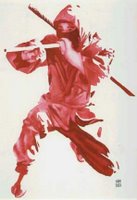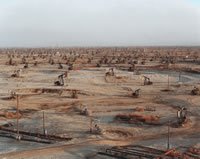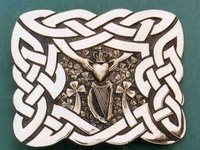.JPG)
In which M2 makes a modest proposal to the city
To say that downtown Los Angeles is, to steal a line from Obi Wan Kenobi (Alec Guinness) in the original Star Wars, “a wretched hive of scum and villainy,” would be one of the understatements of the new century.
Broadway is particularly nasty. The magnificent old buildings, built between the 1910s and the 50s – offices, apartments, coffee shops and theatres – stand largely empty, except for their ground floors. Seedy clothing shops, cheap luggage outlets, five-and-dimes, naughty bookstores, check-cashing offices and all manner of other less-than-wholesome businesses are the major occupants. Just going to see a movie or enjoy a tour at one of Broadway’s classic movie palaces can be an adventure in bum-dodging seediness.
Fact is, downtown L.A. is an awful mess, one that every do-gooder organization in town – as well as the city government itself – has failed to ameliorate. From L.A. cultural critic, Mike Davis, to the French intellectual, Bernard Henri-Levi, many have complained that Los Angeles is a city without a center. Others say Los Angeles doesn’t need one – it’s a city of neighborhoods with a hundred little centers each with its own character (between the strip mall-laden boulevards, that is). Whatever side of the argument you fall on, I think you’ll agree that it’s a damned shame to watch Broadway and downtown fall into terminal decay. But what to do about it?
Give it to Caruso – Rick Caruso, that is.
Caruso, of course, is the
developer of upscale, outdoor shopping experiences – “lifetyle malls,” he calls them – such as The Grove at Farmer’s Market in the mid-Wilshire and the Promenade at Westlake. Caruso’s designers’ deft touch with classic architectural detail, judicious employment of theming, and joyful use of water make his properties more than just malls; they become neighborhood showpieces and central meeting places. I know this for a fact. I lived in Park La Brea for some years, across 3rd Street from
The Grove. It was almost always a delight to go there, sit on the terrace at Ristorante La Piazza and just watch people and enjoy the sunshine, the fountain and the
trolley. I think, given the right incentive, Caruso could transform Broadway from a den of sleaze into the gem of the city.
The L.A. city government should condemn the buildings on both sides of the main part of Broadway, kick most of the existing businesses out and hand them over to Caruso for development for a nominal fee – with the stricture that the overall architectural integrity of the building exteriors be maintained. Provisions would also be made for the preservation of the grand movie palaces – those actually worth preserving, that is. Caruso’s builders would then gut the bulk of the office buildings and old hotels and develop new, state-of- the-art apartments, condos, offices and hotels, with some dwellings set aside for low-income residents. The ground floors would be renovated and new retail business, restaurants, nightclubs and so forth installed. The street itself might be pedestrianized, its sidewalks expanded to accommodate outdoor cafes, and include fountains, garden landscaping and perhaps a trolley.
I know what you’re thinking. Every NIMBY, neighborhood activist, weekly paper editorial writer, preservation fanatic and public policy junkie would jump on such a deal, screaming about the social injustice of it all, suing hither and thither to keep downtown down.
It's a give-away! they'll shout. Accusations of cronyism will fly like starlings to a cornfield.
Let them scream. When the dust clears, 8 or 10 years down the road, and Broadway is a gleaming jewel that everyone can enjoy, that is the center of a vibrant and economically viable neighborhood that draws people from throughout the city and even tourists from abroad, the screams will be all but forgotten.
Similar things happened in San Francisco when I lived there. The city and developers struggled for years to get a new baseball park built downtown, to develop the moribund Embarcadero and create a new museum complex in what was then the S.F. version of skid row. How they howled. But today San Francisco is home to
the most beautiful ball park in America, the Embarcadero is a ribbon of silver light that arcs along the waterfront, decorated in
whimsical sculpture and anchored by a renovated
Ferry Building that serves as the city’s farmer’s market, and the
Yerba Buena and MOMA museum complex is a patch of cultured green amid the steel and glass towers of downtown. No one is screaming now, and the city is a better place for all.
I think Los Angeles can do this downtown, and I think Caruso’s just the man to do it.
When he's done with that, then we'll see what he can do with Alcatraz, a historic eyesore if there ever was one.

 Coming home from a wild warehouse party in the badlands of San Francisco on Sunday morning (more on that later, when I get the pictures), I stopped at Harris Ranch to buy some fresh Harris Ranch beef to bring to some friends at in the south. I bought some pre-cooked BBQ ribs, a Bobby Darren CD and a map – I had forgotten to bring one on the way up.
Coming home from a wild warehouse party in the badlands of San Francisco on Sunday morning (more on that later, when I get the pictures), I stopped at Harris Ranch to buy some fresh Harris Ranch beef to bring to some friends at in the south. I bought some pre-cooked BBQ ribs, a Bobby Darren CD and a map – I had forgotten to bring one on the way up. Looking out over that fertile grassland I tried to imagine it but could not. Moving further southward, however, I could see better the general’s plan. As I sped south, the countryside changed dramatically. Fresno County giving way to Kings County and Kings County to Kern. Grassland gave way to dry, desert alkali soil and tumbleweeds – Patton’s war planners must have thought it a good stand-in for parts of North Africa, where Patton finally took on and defeated Rommel. It must have been a magnificent sight t to see. But the fantasy was short lived.
Looking out over that fertile grassland I tried to imagine it but could not. Moving further southward, however, I could see better the general’s plan. As I sped south, the countryside changed dramatically. Fresno County giving way to Kings County and Kings County to Kern. Grassland gave way to dry, desert alkali soil and tumbleweeds – Patton’s war planners must have thought it a good stand-in for parts of North Africa, where Patton finally took on and defeated Rommel. It must have been a magnificent sight t to see. But the fantasy was short lived. It wasn’t a hot spring, however, but a set of bubbling, oozing, tar pits, rank with the smell of sulphur. Interesting to see, but not something you want to bathe in.
It wasn’t a hot spring, however, but a set of bubbling, oozing, tar pits, rank with the smell of sulphur. Interesting to see, but not something you want to bathe in.









.JPG)


